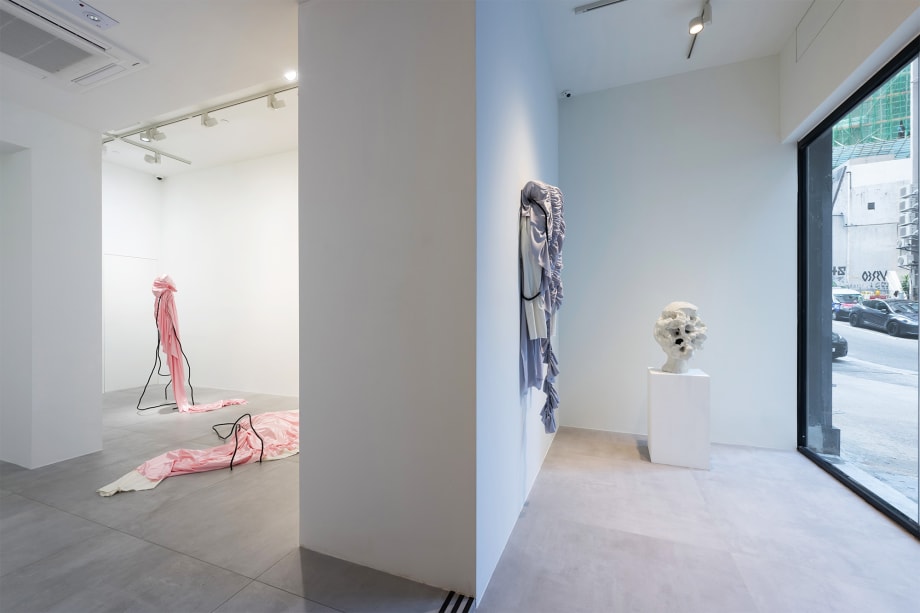Double Q Gallery is pleased to present a duo exhibition featuring Wanda Czełkowska (1930–2021) and Zuza Golińska (b. 1990). The exhibition brings together works by two Polish artists from two different generations and focuses on what are essentially definitive concepts in the 20th century evolution of material and mass-based sculpture, such as sculptural representation and abstraction, and the duality of mass and anti-mass.
Reflecting on the elasticity of the category of sculpture, Rosalind E. Krauss suggested, in a well-known essay published in 1972, that the new approach should be defined as “sculpture in the expanded field.” Although produced in entirely different social and political contexts, this definition applies without exception to the oeuvre of Czełkowska and Golińska. What is immediately striking when looking around the exhibition space is how these works from different periods are closely connected to the millennia-old traditions of figurative sculpture: the archetype behind these compositions is ultimately the human body (and parts of the body, such as the head). In their experimentation with abstraction, Czełkowska and Golińska transform these references into posthuman shapes. In formal terms, the shapes are still suggestive of the human head or body, but in a way that no longer conforms to the conventions of figurative representation or imagery. Instead, what we see are enigmatic posthuman shapes, created by means of abstraction.
Born in 1930, Wanda Czełkowska grew up during the drab years of Polish communism. The sculptures produced in her early period are characterised by their social realism aesthetic: these are raw, robust works that come closest to Etruscan bronzes in terms of their colours and execution. Czełkowska soon rejected the aesthetic demands of the oppressive, totalitarian system; following the death of Stalin, she was able to discover her own individual creative path in Poland’s more relaxed atmosphere. Her sculptures focus almost obsessively on the head motif, while her formal inspiration comes from ancient Minoan and Etruscan art. Prototypes for the distorted head shapes in the “Heads” series, produced between 1964 and 1972, might also include the monumental Moai statues on Easter Island. The work on display here, “Head 1972/2018,” belongs to this series. In this case, the artist has dissolved the human head into a collection of molecular forms, at once suggestive of cells viewed under a microscope and craters formed by the impact of a meteorite. Unusually, Czełkowska keenly followed the results of scientific research undertaken during the period of state socialism, including cybernetics and astrophysics. Besides innovations such as these, her evolving oeuvre, which spanned more than five decades, was in many respects associated with neoprimitivism and the abstraction of the 1960s, which culminated in the extremes of brutalist deconstruction. When asked by Anke Kempkes whether her head sculptures depicted women or men, the artist replied: “a third gender.”
Czełkowska’s oeuvre embraces a variety of media, including sculpture, installations, paintings, drawings, and photography. Her work is characterised by the crossing of genre boundaries. As in the case of sculpture, she also reformulated the definition of panel painting. She often arranged untreated canvases on stretchers into vast installations, and in the case of the unprimed canvases used for her easel paintings like the work on display here, she worked exclusively in charcoal and tempera rather than paints. Researchers have suggested on more than one occasion that her work merits re-examination from a feminist perspective. This would seem to be justified by the fact that Czełkowska consistently referred to herself as a sculptor, deliberately rejecting the term sculptress throughout her career.
Zuza Golińska was born in 1990 in Gdańsk and currently lives in Warsaw. In 2015, she graduated from Mirosław Bałka’s Studio of Spatial Activities at the Academy of Fine Arts in Warsaw, where her supervisor was Anda Rottenberg. Her early works explored the connection between public spaces, architecture, and human beings. Her creative approach is characterised by the production of site-specific installations that summarise experiences gathered during her fieldwork, compelling viewers to re-examine the concepts of social structures and space. Her work is hugely influenced by her observations of human behaviour in architecturally composed public spaces that are used according to certain conventions.
Golińska’s most recent sculptures are enigmatic compositions suggestive of human bodies and heads that have solidified into posthuman shapes in the process of transformation. Works produced using soft textiles and hard steel exploit both the duality of the different types of material as well as the tensions generated by forms and anti-forms. The satin elements, sometimes arranged in billowing curves and sometimes falling in soft drapes, still hold out the promise of mouldability and plasticity, whereas the rigidity of the steel elements, suggestive of the spatial effect of pencil drawings, would seem to point to the finality of the arrangement. The spatial expansion of these lines simultaneously possesses an independent staticity and functions as a structural element that shapes the soft textiles. Their existence is both independent and symbiotic. The artist has even colour-coded the different materials according to their rigidity. The hard, independently static steel arches that provide the spine of the sculpture are painted black, whereas the soft, fleshy parts that provide the body of the sculpture are ethereal pink and shades of grey. Based on these colour codes, either a feminist reading of colours comes to mind, or, in the context of the cult of the body, pink as a symbol of youthfulness and grey as a symbol of the corpse. Furthermore, viewed as posthuman abstractions of human forms, these compositions might also belong to a third gender in just the same way as Czełkowska’s head sculptures. The black steel elements are also powder painted in the same way as objects in the public realm and represent industrial reality, while the satin fabrics are typically only used for indoor settings especially at home and represent domestic reality.
— Mónika Zsikla


